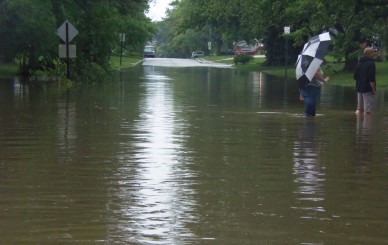On a lovely summer evening, you’ll families wandering from yard to yard in the Johnson Addition neighborhood. The smell of barbeque smoke in the area and the sound of children running through the streets catching fireflies. Everyone knows their neighbors and families feel safe letting their kids play outside. It’s almost like a scene out of “Leave it to Beaver.”

“It was built by the Greatest Generation for their children and grandchildren,” said Chuck Ford, who has lived on Lantern Lane for 25 years. “Our neighborhood signifies that era of neighborliness and safety and family. It’s everything that we as a country ought to get back to.”
Over the past 20 years – or even five years – Carmel has changed so much. Archways were built and the Carmel Arts & Design District was created. The Monon Trail extended into Hamilton County. The Palladium. The Carmel City Center.
But right in the middle of all of this growth, there’s this neighborhood just south of Main Street that still feels the same. Modest ranch-style homes built in the 1950s and 1960s that represent a quieter era for Carmel.
“It really is Americana at its best,” said Mary Eckard, who has lived on Lantern Lane for 11 years. “There are plenty of subdivisions, but this is a neighborhood.”
But its future is at a crossroads. New condominium buildings will be constructed nearby for the $100-million-plus transformation of the Midtown area. There’s a proposal to rezone residential properties on Main Street nearby into a commercial zone. Dangerous storm-water flooding threatens the old streets in the historic neighborhood, necessitating infrastructure upgrades.
Some are worried that history will be torn down and replaced.

Recently, Eckard and Ford supported an effort to turn their neighborhood into a “conservation district” in order to preserve the traditional look of their area. It passed the Carmel City Council with a 4-3 vote but Mayor Jim Brainard vetoed the bill and there weren’t enough votes to override the veto.
But there’s hope. Brainard has suggested a new proposal that could help preserve the look of the area and many say it could be different enough from a “conservation district” that even its toughest critics could be converted to the cause.
THE CONSERVATION DISTRICT
Creating the “conservation district” was a polarizing issue. Critics told the City Council that they worried that they wouldn’t be able to paint their house a certain color or make renovations. They said that the petition – which showed a majority of residents supported it – was conducted in an improper manner. They said meetings weren’t notified properly. Emotions ran high at the public comment section of the council meetings.
Eckard and Ford both get upset when they hear those criticisms because they say that’s not true.
But after Brainard’s veto was announced at the City Council meeting in November – and it wasn’t successfully overturned – the mayor turned around in his seat and whispered to Ford that he was going to call him soon with an idea.

The mayor said that the Carmel Historic Preservation Commission – who assisted in the efforts – did not post public notice of meetings on Feb. 13, March 13, April 17, June 12 and Aug. 14. An Oct. 2 meeting was posted though. As a result, if a neighbor didn’t like this law, that person could sue the city for passing a law that wasn’t properly noticed, he said.
“The Johnson Conservation District was discussed at multiple public meetings that were not noticed,” Brainard wrote at the time. “This is a fatal flaw in the process that would put the city in a non-defensible position if it were sued. More importantly, transparent and open government is paramount; secret meetings cannot be countenanced.”
To this day, Eckard and Ford disagree with that characterization, but they are moving on to new battles. Ford said, “I don’t care which horse gets me to the dance. I just want to get to the dance.”
THE NEW PLAN
The new idea is to turn the neighborhood into an “overlay zone” which is a zoning classification that protects parts of the city with certain guidelines, such as height restrictions and architectural conformity. There’s a public hearing scheduled before the Carmel Plan Commission on March 17 and any neighbors are encouraged to attend to speak for our against the idea.
“I think we have a good consensus,” he said. “I think it’s a better answer to the neighborhoods concerns. People are still allowed to tear down the house and reconstruct but this makes sure it all fits with the same look and feel of the rest of the neighborhood.”
Brainard said one of the reasons this plan is better is because the conservation district would have automatically become a historic district if they didn’t take action after a certain period of time. There’s no such concern with the overlay.

“I think the mayor has come a long way in appreciating what we’re trying to do,” Ford said. “It’s very similar to the conservation district that we proposed.”
City Council President Rick Sharp, who voted for the conservation district, said he thinks the overlay should be done under the control of the Carmel Historic Preservation Commission instead of the city.
“I don’t think the overlay goes far enough,” he said. “I think the veto was for political reasons and there’s a chance that overlay is for political reasons as well.”
There are some important changes. Since the overlay is done by the city, all of the plan commission guidelines will be followed so any concerns about public notice or lawsuits should be eliminated. Petitions and age of the homes don’t need to be considered. And many homes along Main Street have been eliminated from the boundaries that were included in the conservation district, a point that presented some opposition, especially from City Councilor Sue Finkam.
“I’m very happy with that because Main Street has a different feel and didn’t belong in the conservation district,’ she said.

Michael Houser, a neighbor who opposed the conservation district, worries that a small group of people might bully others who disagree.
“There are really too many unanswered questions at this point to form an opinion on the matter but I am deeply concerned that once again this has been done by their small group without the input from the entire neighborhood,” said Houser, who has live on Sherman Drive for four years.

Brainard said that won’t be the case because the effort is being handled by the city and not neighborhood petitioners or the historic preservation commission. Since the plan commission is handling the matter, he said transparency will be assured.
“What we don’t want is McMansions where there are big homes that overshadow the area,” he said. “We want the same feel to continue.”
[gview file=”https://youarecurrent.com/wp-content/uploads/johnson-addition-overlay-2-2015.pdf”]THREAT OF FLOODING
Sharp, who is seeking to unseat Mayor Brainard in the May primary election, said he thinks there’s a lot of attention being put on “shiny new things” such as the Carmel City Center. And while he said it’s great to build in the city’s urban core, he said you can’t forget about these older neighborhoods.
“For years, this area has been ignored,” he said.
The older streets in the neighborhood – especially along Emerson Road – have been in need of repair. Heavy rains lead to dangerous flooding because there’s not adequate drainage for storm water. The City Council recently created a new utility called the “Storm Water District” which charges around $5 a house to help pay for infrastructure improvements.

Brainard said he’s wanted to spend money on that for years but the council fought him on that. Sharp disagrees with that characterization.
“We stopped the blight that started to take place in the Arts & Design District and now we want to use our tax revenue to reinvest in this community which is why we are improving drainage in the area,” he said. “We don’t want to abandon these older neighborhoods. That’s why we spent so much effort on the Arts & Design District. There’s a lot of demand for these type of houses.”
Sharp brought up a quote that City Councilor Ron Carter said at a storm water district meeting about fixing up the neighborhood. Carter was quoted in the Current in Carmel as saying, “Are we talking about a situation where we would be spending more money to fix a project than the houses are worth?”
City Engineer Jeremy Kashman confirmed at the meeting it could be the case, saying, “Which is why we have tried to make low cost improvements.”
City Councilor Eric Seidensticker jumped on Carter’s comments, calling them disappointing. Sharp and City Councilor Luci Snyder have also brought it up again, saying it plays into a mindset that certain parts of town don’t matter in the eyes of some because they homes aren’t as expensive.
Carter has said repeatedly that he feels his words are being twisted in an election year and that he was just asking a question not advocating for any particular position.
Ford said he’s happy with the city’s efforts to improve drainage in the area.
Of course, when discussing the problem in the past, the phrase “eminent domain” was used, which alarmed some neighbors. That situation started because a homeowner in the area actually contacted the city and offered to sell his house so the city could tear it down and put a retention pond there to inexpensively fix the drainage problems. No serious discussions were had but this concerned some.

At the storm water meeting, there was a conversation about what would happen if a homeowner didn’t allow the city to cut through a small strip of their yard to bury a drainage pipe. Officials said they couldn’t imagine why a homeowner would say no – the grass will regrow over the work and be just like their yard and they still own the land – but if that happen they could conceivable use eminent domain.
Well, just uttering that phrase rang some bells. People thought their houses were going to be seized and torn down. That wasn’t the case, but it just shows the overall feelings in the area.
“That term eminent domain creates panic,” Seidensticker said at the time. “I don’t believe it’s likely that a court would uphold a city taking someone’s house to build a retention pond.”
NEW CONDOS AND DEVELOPMENT NEARBY
Some neighbors are split in their feelings about new construction in the area. Some complain that street festivals and events mean that random people park in front of their houses and that they have to worry about noise and traffic. Other say that’s ridiculous and that they love being able to walk to a restaurant to have dinner on a nice summer evening.
No matter your opinion, one thing is for sure: more is coming.
Just to the south of the Johnson Addition neighborhood, there’s unused land near Bub’s Café and Happy Dog Hotel and Spa that’s being sold by the Carmel Redevelopment Commission. Two bidders are being considered: Barrett & Stokely and Old Town Design Group, both of which have been active in building rental units and empty nester homes throughout Carmel. Barrett & Stokley bid $2.5 million and Old Town big $1.72 million for the land situated west of the Monon Trail, south of 2nd Avenue SW and east of 3rd Avenue/4th Avenue SW.

Just east of the Johnson Addition boundaries, art gallery owner Soori Ardalan wants to rezone a piece of property along Main Street she has so she can tear down a house and build a commercial building similar to the size of the nearby Evan Lurie Building. It’s early in the process, but Beth Meyers, who owns a yellow cottage home near the proposed rezone, said she has many unanswered question.
“I haven’t been told anything about what it could be,” she said. “I’m just concerned because I wouldn’t want a restaurant next to me. The parking, the traffic, the smell.”
Kelly Baskett, who lives at 400 Emerson Road, said she’s about 100 feet away from the property and she’s concerned how it might change the character of the area.
“I don’t like a large structure in the middle of where we have homes,” she said. “That’s a very daunting and bullying kind of structure. We don’t want to lose our character.”
Ford emphasized that the rezone issue to the east of Johnson Addition and he’s kind of staying out of that debate.
Bruce Kimball, who is running against Seidensticker to represent this part of town on the City Council, said it’s not an “either/or” situation. He said you can support growth and keep these neighborhoods.
“I think this neighborhood plays a large part into the overall idea of what we’re trying to do in Carmel,” he said. “All of the development that’s going on is just going to benefit these neighbors. They are part of a walkable community where they can walk or bike just a short distance to an awful lot of great amenities.”

Just along 1st Avenue SW, Justin Moffett’s Old Town Design Group is building a custom house on a vacant lot just east of the Johnson Addition neighborhood.
Eckard said she feels that builders like Moffett recognize the value of homes in the area. Although she prefers bigger backyards than some of his other homes he built, she said she trusts Moffett to help preserve this area.
“We hear that there’s a list of fifty people that want to find houses just like these with backyards and smaller ranch style homes,” she said. “You really need to have a diversity of housing and not just apartments. You need families that can walk their kids to school.”
Ford said he likes that he can walk to a restaurant in the Arts District and that the new buildings in Midtown will only increase his property values. He said he supports the growth as long as developers don’t come in and tear down their ranch-style homes and build large mini-mansions with no yard space.
“To tear this down and just make everything glitzy and new just adds to any of the negative image that some people have about Carmel,” he said. “We should have a better image than that.”
Eckard said that concern has been growing ever since a prominently large house was built along Main Street near the 4th Avenue SW roundabout in 2014.
“Once the big house on the corner went up, that was kind of a signal to people that, ‘Gosh, it really is different,’” she said.
She said she understands that the homes are old and might need some updates and repairs but she would love to see people fix up what’s already there instead of tearing it down, especially since there’s such a high demand for these homes.
“If you tear down our history, you are doing an injustice to people who lived in those times,” she said. “Life was a certain way back then. We knew our neighbors. We cared about our property. We felt safe. We walked everywhere. That’s the best thing I ever did for my life. Otherwise I wouldn’t be as old as I am. We get the exercise from walking. There are so many benefits.”
What is an Overlay Zone?
It’s a regulatory tool that creates a special zoning district over an existing base zone that identifies special provisions for the area.
What are the notable rules for new buildings?
- May not exceed the height of the tallest dimension of the nearest two principal buildings on the same side of the street by seven feet.
- Must follow the dominant or average front yard setback dimensions.
- Must conform to the rectangular ranch floor plans.
- Wide house fronts compared to depth.
- Open front porches.
- Attached garages in line with or slightly forward of the home






